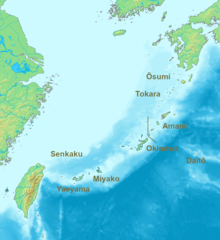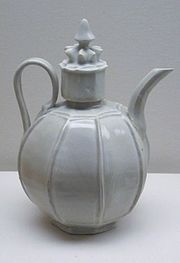Gusuku Period
The period corresponds to the spread of agriculture and Japonic culture from Japan alongside increased social organization, eventually leading to endemic warfare and the construction of the namesake gusuku fortresses.
The land bridges were gone by the time of the Late Pleistocene settlement of the Ryukyus around 32,000 years ago, requiring Paleolithic humans to have arrived at the islands via boats.
[3] Hunter-gatherer groups originating from Kyushu began to populate the northern and central Ryukyus around 5000 BCE, although recently-discovered sites suggest possible initial dates around 12,000 to 7000.
[6] The Shellmidden people exploited plentiful shellfish and reef fish populations, hunted Ryukyu wild boar, and possibly tended domestic pigs.
[7][8] Although other East Asian populations adopted agriculture long before the beginning of the Common Era, no cereal cultivation occurred in the Ryuykus before c. 800 CE, with plant foods largely limited to nuts.
However, following archaeological evidence for subsistence agriculture and greater social complexity prior to this date, 21st century sources have largely redefined the period as lasting from c. 1050 to c. 1429.
[20] During the 9th century, the Dazaifu (the regional Japanese government in Kyushu) established the Gusuku site[γ] on the island of Kikai as a trading outpost.
[21] Beginning in the 11th century, large numbers of agrarian Japonic-speaking peoples settled the Ryukyus, with Kikai as the origin of various successive migration waves across the archipelago.
[22][23] This migration was likely motivated by access to various trade goods found in the southern islands, highly coveted in Song China and by the aristocracy of Heian Japan.
[24] The indigenous population of the Ryukyu Islands prior to the Gusuku Period was of the non-Japonic Jōmon ancestry, with little of the Yayoi genetics prevalent in mainland Japan.
[25] Due to their shared set of innovations absent in Japanese, the modern Ryukyuan languages are generally thought to form one of the two or three main branches of Japonic,[δ] descended from a common Proto-Ryukyuan origin.
This linguistic divergence long before the Gusuku Period suggests a pre-Proto-Ryukyuan[ε] homeland in southern Kyushu and the surrounding islands.
[28][29][30] Earlier, now-discredited, theories attribute the emergence of Proto-Ryukyuan to either the Japonic-speaking Hayato people settling the Ryukyus after the conquest of southern Kyushu by the Yamato state, or as an evolution from a trade pidgin on Kikai.
[32] Cereal crops such as rice, barley, wheat, and foxtail millet have been found in Gusuku Period sites, alongside possibly beans.
Historians and archaeologists have generally analyzed the Gusuku as a stratified agrarian society, attributing the formation of states and nobility to this agricultural base.
The largest were massive stone fortresses enclosing elite residences, shrines, and work areas oriented around a central plaza.
[50] Trade links between Kyushu and the central Ryukyus date to the Shellmidden Period, with shells as the primary export in exchange for Japanese pottery.
The transition into the Gusuku Period saw trade expansion and the import of both Chinese ceramics and Japanese soapstone cauldrons from Kyushu, which were used in the Ryukyus alongside the locally-produced earthenware.
[51][52][53] By the late 12th century, they began importing ceramics (such as Qingbai ware and celadon) directly from China, including forms of pottery not found in the main Japanese islands.
While merchants from Miyako and other islands in Sakishima sailed directly to Southeast Asia, rulers in Okinawa hired Chinese ships and crews to travel to the region.
[59][60] Both contemporary Ming dynasty tribute records and later Ryukyuan official histories state that Okinawa was divided into three kingdoms, collectively termed the Sanzan, during the 14th and early 15th centuries: Sanhoku in the north, Chūzan in the center, and Sannan in the south.
They may not have corresponded to territorial control on the island, instead serving as labels which various powerful lords operated under during diplomatic and trade relations with the Ming.
[65] During this period, the southern Ryukyu Islands were ruled by a series of local warlords with some trade connections to Shuri and the Shō dynasty.
His son Shō Shin (r. 1477–1526) oversaw the centralization of the Ryukyu Kingdom at Shuri and the subjugation of the outlying islands of the archipelago, such as Yaeyama.
Largely based on Confucian historiography and principles, it is not possible to corroborate most information from the official sources dating to periods before the 16th and 17th centuries.
Due to this early date for unification, what the official histories depict as internal rebellions over the following decades may have been wars between Chuzan and neighboring polities.
[79] Zenchū Nakahara, writing in the 1950s, was among the first historians to identify the major cultural discontinuity between the Gusuku Period and earlier stages of Ryukyuan prehistory.
Highly skeptical of the Ryukyuan official histories that formed the basis of prior historians' work, he based much of his research off the Omoro and the limited archaeological knowledge available at his time, focusing on the emergence of the aji, migrations from Japan, and endemic warfare in the twelfth century.
Other contemporary historians, such as Inamura Kenpu and Higa Shunchō, also identified the Gusuku as a distinct period, viewing it as a social and political transformation of an existing Japonic culture in Ryukyu analogous to Japan's earlier development.
[80] The centrality of Japan to development in the Ryukyus was challenged in the 1980s and 1990s in favor of a mainly domestic origin, with historians such as Takara Kurayoshi and Murai Shōsuke emphasizing the independent emergence of a complex political order on Okinawa from agricultural surplus during the Gusuku Period, often placing more credence into the official histories.





